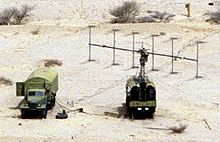P-12
Under the designation P-12 ( Russian П-12 ) was a Soviet radar set that worked with extremely low transmission frequencies (VHF band). The NATO code was "Spoon Rest".
Several modifications of this radar device were made:
- P-12 MA : oldest version on truck type ZIL-157 (NATO code: "Spoon Rest A")
- P-12 NP : Hanger version in two hangers type 700G (NATO code: "Spoon Rest B")
- P-12 NA : latest version on truck of the manufacturer Uralsky Avtomobilny Zavod (NATO code: "Spoon Rest C")
The main differences between these stations were the various options for coupling them to other radar devices, automated command and control objects, or weapon systems. The main area of application of the truck versions was the anti-aircraft missile complex S-75 "Volkhov"
Radar device
| Technical data P-12 | |
|---|---|
| Frequency range | 150-170 MHz |
| Pulse repetition time | 2.77 ms |
| Pulse repetition frequency | 360 Hz |
| Transmission time (PW) | 6 µs |
| Reception time | 2.4 ms |
| Dead time | 377 µs |
| Pulse power | 160-250 kW |
| Average performance | up to 540 W |
| displayed distance | up to 360 km |
| Distance resolution | 900 m |
| Opening angle | 8 ° |
| Hit count | over 15 |
| Antenna round trip time | ≥ 6 s (continuously adjustable) |
The blocks of a very effective interference protection system can be seen above the panoramic device. A very stable coherent oscillator working in a thermostat and two potential storage tubes were the core of this system. It was able to suppress fixed targets and non-synchronous impulse interference at the same time and was equipped with wind compensation (MTI) against chaff (radar deception) .

